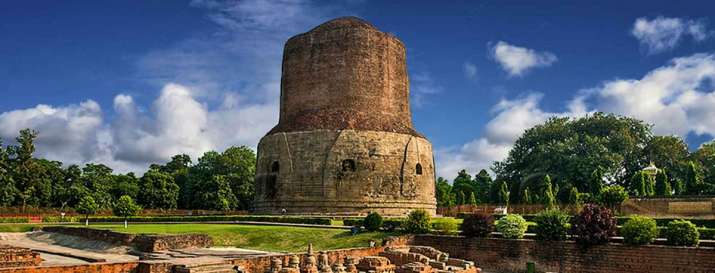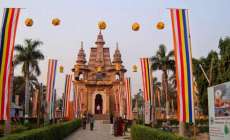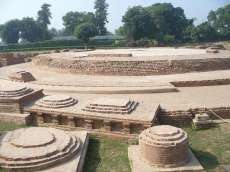NEWS
UNESCO Listing Proposed for Sarnath, Site of the Buddha’s First Sermon
 Dhamekh Stupa at Sarnath. From daiwikhotels.com
Dhamekh Stupa at Sarnath. From daiwikhotels.comThe Varanasi circle of the Archaeological Survey of India (ASI) this week forwarded a proposal to place Sarnath on the United Nations Educational, Scientific, and Cultural Organization’s (UNESCO) list of World Heritage Sites to India’s Ministry of Culture. If listed, Sarnath will become the fourth UNESCO World Heritage Site in the Indian state of Uttar Pradesh and the 39th for the country.
Some eight kilometers from the city of Varanasi, Sarnath is believed to be where the Buddha conducted his first teaching, the Dharmacakrapravartana Sutra (Setting the Wheel of the Dharma in Motion Sutra). Today, Sarnath is home to a large archeological site that includes the imposing Dhamekh Stupa, marking the site of the Buddha’s first teaching, several modern temples representing Buddhist schools from around the world, and the Sarnath Museum, housing thousands of Buddhist and other religious and cultural antiquities from the area.
“Sarnath is a suitable case for the UNESCO tag. It is a tangible heritage with scores of unique features to build a strong case,” said Neeraj Kumar Sinha, superintendent archaeologist for the Varanasi circle of the ASI. Speaking of the process for gaining World Heritage designation, Sinha noted: “This is the first attempt to get Sarnath a place in the permanent list. We can apply because Sarnath made it to the tentative list way back in 2003.” (Times of India).
 Mulagandhakuti Vihara. From indiatourism.guide
Mulagandhakuti Vihara. From indiatourism.guide Dharmarajika Stupa. From wikipedia.org
Dharmarajika Stupa. From wikipedia.orgAccording to the Buddhist tradition, after the Buddha attained awakening at Bodh Gaya, some 200 kilometers to the east, he walked to Sarnath where he encountered five disciples who had been studying with him until leaving him in disgust after he took food from a passing village girl named Sujata. Upon seeing him in the distance, the ascetics devised a pact to leave once he drew near. But when the Buddha drew closer, his glowing countenance entranced them and they stayed to hear his teaching. All of the ascetics gained awakening shortly after the Buddha’s first teaching and soon more people came from Sarnath, Varanasi, and the surrounding areas to listen and to be ordained.
The emperor Ashoka (302–232 BCE) built a stupa to mark the site of the Buddha’s first teaching and erected one of his famous pillars with an edict forbidding activities that might lead to a split in the community. The Buddhist community and monasteries that developed in the area are featured in the histories recorded by the early Chinese pilgrims Faxian (337–422 CE) and Xuanzang (602–64 CE).
Today, Sarnath is one of the holiest pilgrimage sites for Buddhists around the world, and is among the top four sites from the Buddha’s that Buddhist pilgrims hope to visit —the others being Lumbini in Nepal, where the Buddha is beleived to have been born as Prince Siddhartha Gautama; Bodh Gaya, where he attained enlightenment; and Kushinagar, the site of his Parinirvana. “On this count, Sarnath has a natural edge. It is the birthplace of Buddhism. It shares a religious, historical, and emotional bond with people in Thailand, Myanmar, China, Japan, Korea, Sri Lanka, and Bhutan,” said Sinha. (Times of India)
Along with the Dhamekh Stupa, Sarnath is home to the Dharmarajika Stupa, which marks the formation of the Dharma and the Sangha and the Moolgandhkuti, where the Buddha is said to have spent his first vassa or rainy season retreat.
UNESCO’s World Heritage Committee meets yearly to select new sites based on six cultural and four natural criteria. A site needs only to meet one of the criteria to qualify. The cultural criteria include exhibiting “an important interchange of human values over a span of time, or within a cultural area of the world, on developments in architecture or technology, monumental arts, town-planning, or landscape design,” and “is directly or tangibly associated with events or living traditions, with ideas, or with beliefs, with artistic and literary works of outstanding universal significance.” (UNESCO)
According to the Times of India, Indian prime minister Narendra Modi has taken a personal interest in advancing the World Heritage designation of Sarnath. One hurdle noted, however, is the presence of a number of illegally constructed buildings near the site.
See more
Sarnath eyes Unesco world heritage status (Times of India)
The Criteria for Selection (UNESCO)
Related news from Buddhistdoor Global
Gautam Buddha International Airport Due to Open Near Lumbini, Nepal, in Mid-2020
New Low-cost Flights Announced for Buddhist Pilgrimage Circuit in India
Air Pollution Levels Threaten Birthplace of the Buddha
Indian PM Invokes the Buddha in Contentious Elections
UNESCO Head Commends International Conservation Effort in Lumbini
Related features from Buddhistdoor Global
The Heart of Pilgrimage
Pilgrimage
Buddhism and India – The Child Returns Home . . . ?
Buddhism as a Bridge between India and the World: An Interview with Prof. Shashi Bala, Part One














